The area of catch crops grown is likely to increase significantly this year, as approximately 1,300 farmers have applied to grow these crops under the Farming for Water pilot project.
This European-funded programme pays farmers significantly more than ACRES and gives growers a payment for short-term catch crops grown ahead of winter crops.
Outside of payments of course, catch crops have a number of benefits, from taking up nutrients left in the soil from the previous crop and preventing loss to water, to providing winter feed for animals, to increasing soil organic matter levels, helping soil structure and improving soil carbon storage.
Depending on what job you are doing, you will require a different plant. For example, if you are feeding animals, you will want a crop that will provide, bulk and energy like forage rape or stubble turnips. Those turnips, or something like tillage radish, could help to break up compaction in the soil, while a crop like phacelia will make the soil crumbly on top.
Legumes like vetch and clovers will fix nitrogen and possibly make it available to the next crop, while buckwheat is thought to make phosphorus more available.
However, you need to be careful what you choose. If you grow oilseed rape in your main rotation you should avoid brassica crops like rape in a catch crop, as it could help to carry club root.
Seed requirements
If you are planting crops under a scheme you need to follow certain requirements. The Farming for Water pilot project requires two species in a mix and the advice is generally to follow the ACRES guidelines. In ACRES, minimum seed rates need to be used, as outlined in Table 1.
While two species are required in the mix, the ACRES guidelines recommend using three or more species “to extend the functionality of the mix”.
If you use more than two species you still need to grow at least two species, using the minimum seed rates outlined in Table 1.
The other species in the mix can be included at whatever rate you wish. If you want to include a species that is not on the list, you can ask for approval from the Department of Agriculture by emailing ACRES@agriculture.gov.ie.
There are plenty of mixes on the market which are made to meet the requirements of ACRES. If you want to make a mix that you think would suit your farm better than these mixes, you can order it from a seed company.
You need to keep the dockets for your seed in case of inspection for all measures or requirements. Keep the dockets for ACRES and Farming for Water separate, don’t buy all the seed on one docket.
Here are some examples of seed mixes on the market:
Leafy turnip and forage rape.Oilseed radish and phacelia.Vetch and phacelia.Oats and black oats.Tillage radish, fodder radish, white mustard, forage rape, brown mustard, crimson clover, linseed, phacelia.Crimson clover, berseem clover, vetch, phacelia.Phacelia, crimson clover and vetch.Vetch, phacelia, crimson clover, forage rye.Crimson clover, vetch, phacelia, buckwheat, linseed, black oats, sunflower.Black oats and crimson clover.Time of sowing
The dates to sow catch crops by are outlined in Table 2, 15 September for ACRES and 1 September and 1 August for Farming for Water, but really to get the most from your investment catch crops should be planted as early as possible.
With winter barley being harvested early it is an ideal time to plant. Think of the old saying: “a day in July is worth a week in August and a month in September”.
Teagasc research on mustard catch crops shows that there is a 2t DM/ha loss for each three-week delay in sowing.
Clean seed
The majority of catch crop seed is imported and as other countries do not have seed standards as high as Ireland, it is important to buy trusted seed. When purchasing seed you should look for an Irish Seed Trade Association sticker and label, which outlines that the seed adheres to a higher voluntary standard that Irish seed companies have implemented.
This means that a 3kg sample has been taken from each seed lot and examined for blackgrass. If it is free of the weed it will receive a higher voluintary standard sticker.
It should be noted that not all catch crop seed follows this higher voluntary standard, so you need to request it.
Grazing catch crops
If you are grazing a catch crop you need to leave a 3m uncultivated and unsown buffer around the perimeter of the field and this buffer extends to 4m at a watercourse, where you already have a 3m grass buffer you can just extend it with 1m of uncultivated land. The watercourse should be fenced to 1.5m.
In total, 70% of the area can be a catch crop, but the remaining 30% needs to be a lie-back area for animals. This can be grass or else should be cultivated in line with nitrates rules.
If you intend to graze a catch crop which is being used for crop diversification rules or a scheme, you need to include the buffers and the buffers cannot be included in the cover crop area.
Crop diversification
If you only grow one crop on you farm and you have more than 10ha of that crop then you need to meet crop diversification requirements using equivalence. This is where you plant 50% of the total area of arable land on the farm in catch crops.
The crop must be planted by 15 September and remain in place until 1 December. If this rule applies to you, you have probably used it in previous years and will be familiar with it.
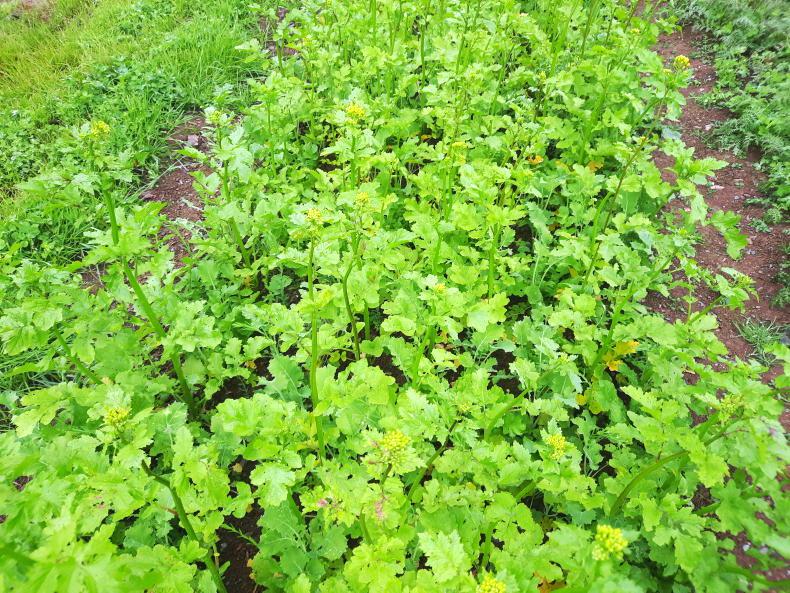
Mustard.

Phacelia.

A catch crop with an eight-way mix.

Leafy turnip.
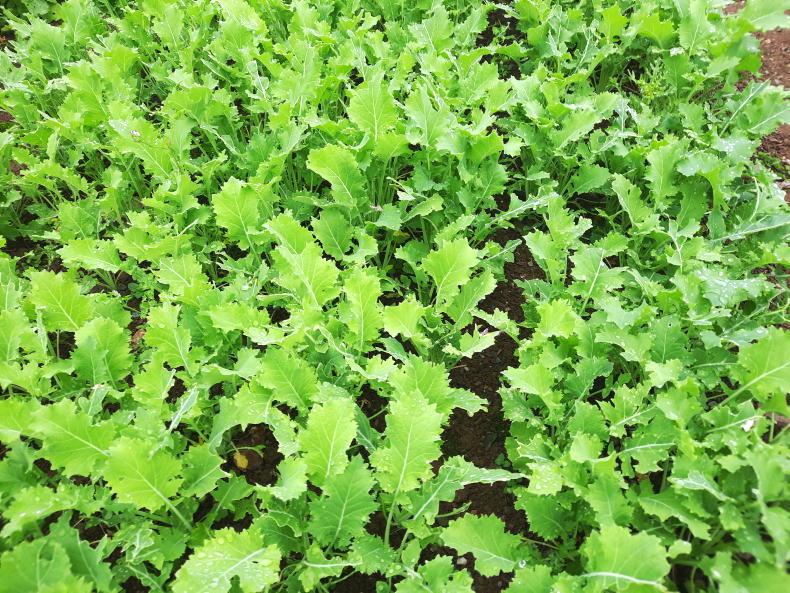
Forage rape.
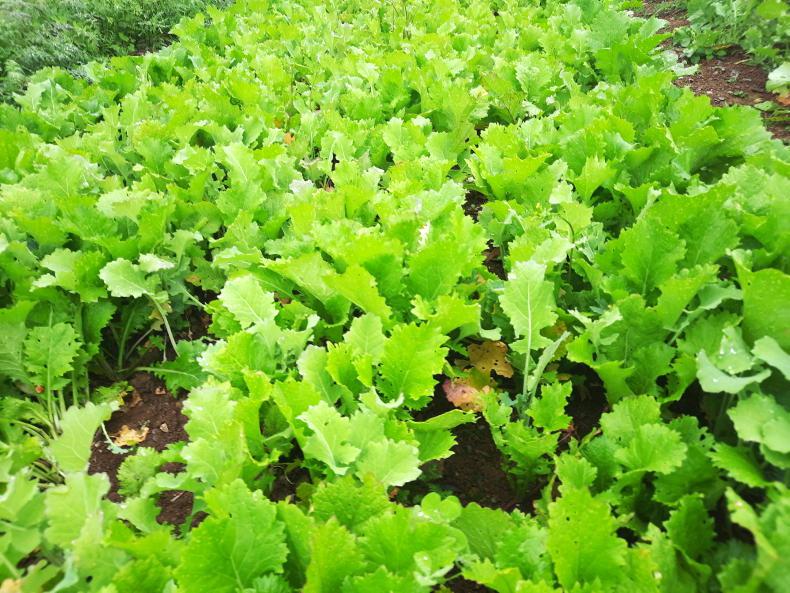
Leafy turnip and forage rape sown in a mix.
The area of catch crops grown is likely to increase significantly this year, as approximately 1,300 farmers have applied to grow these crops under the Farming for Water pilot project.
This European-funded programme pays farmers significantly more than ACRES and gives growers a payment for short-term catch crops grown ahead of winter crops.
Outside of payments of course, catch crops have a number of benefits, from taking up nutrients left in the soil from the previous crop and preventing loss to water, to providing winter feed for animals, to increasing soil organic matter levels, helping soil structure and improving soil carbon storage.
Depending on what job you are doing, you will require a different plant. For example, if you are feeding animals, you will want a crop that will provide, bulk and energy like forage rape or stubble turnips. Those turnips, or something like tillage radish, could help to break up compaction in the soil, while a crop like phacelia will make the soil crumbly on top.
Legumes like vetch and clovers will fix nitrogen and possibly make it available to the next crop, while buckwheat is thought to make phosphorus more available.
However, you need to be careful what you choose. If you grow oilseed rape in your main rotation you should avoid brassica crops like rape in a catch crop, as it could help to carry club root.
Seed requirements
If you are planting crops under a scheme you need to follow certain requirements. The Farming for Water pilot project requires two species in a mix and the advice is generally to follow the ACRES guidelines. In ACRES, minimum seed rates need to be used, as outlined in Table 1.
While two species are required in the mix, the ACRES guidelines recommend using three or more species “to extend the functionality of the mix”.
If you use more than two species you still need to grow at least two species, using the minimum seed rates outlined in Table 1.
The other species in the mix can be included at whatever rate you wish. If you want to include a species that is not on the list, you can ask for approval from the Department of Agriculture by emailing ACRES@agriculture.gov.ie.
There are plenty of mixes on the market which are made to meet the requirements of ACRES. If you want to make a mix that you think would suit your farm better than these mixes, you can order it from a seed company.
You need to keep the dockets for your seed in case of inspection for all measures or requirements. Keep the dockets for ACRES and Farming for Water separate, don’t buy all the seed on one docket.
Here are some examples of seed mixes on the market:
Leafy turnip and forage rape.Oilseed radish and phacelia.Vetch and phacelia.Oats and black oats.Tillage radish, fodder radish, white mustard, forage rape, brown mustard, crimson clover, linseed, phacelia.Crimson clover, berseem clover, vetch, phacelia.Phacelia, crimson clover and vetch.Vetch, phacelia, crimson clover, forage rye.Crimson clover, vetch, phacelia, buckwheat, linseed, black oats, sunflower.Black oats and crimson clover.Time of sowing
The dates to sow catch crops by are outlined in Table 2, 15 September for ACRES and 1 September and 1 August for Farming for Water, but really to get the most from your investment catch crops should be planted as early as possible.
With winter barley being harvested early it is an ideal time to plant. Think of the old saying: “a day in July is worth a week in August and a month in September”.
Teagasc research on mustard catch crops shows that there is a 2t DM/ha loss for each three-week delay in sowing.
Clean seed
The majority of catch crop seed is imported and as other countries do not have seed standards as high as Ireland, it is important to buy trusted seed. When purchasing seed you should look for an Irish Seed Trade Association sticker and label, which outlines that the seed adheres to a higher voluntary standard that Irish seed companies have implemented.
This means that a 3kg sample has been taken from each seed lot and examined for blackgrass. If it is free of the weed it will receive a higher voluintary standard sticker.
It should be noted that not all catch crop seed follows this higher voluntary standard, so you need to request it.
Grazing catch crops
If you are grazing a catch crop you need to leave a 3m uncultivated and unsown buffer around the perimeter of the field and this buffer extends to 4m at a watercourse, where you already have a 3m grass buffer you can just extend it with 1m of uncultivated land. The watercourse should be fenced to 1.5m.
In total, 70% of the area can be a catch crop, but the remaining 30% needs to be a lie-back area for animals. This can be grass or else should be cultivated in line with nitrates rules.
If you intend to graze a catch crop which is being used for crop diversification rules or a scheme, you need to include the buffers and the buffers cannot be included in the cover crop area.
Crop diversification
If you only grow one crop on you farm and you have more than 10ha of that crop then you need to meet crop diversification requirements using equivalence. This is where you plant 50% of the total area of arable land on the farm in catch crops.
The crop must be planted by 15 September and remain in place until 1 December. If this rule applies to you, you have probably used it in previous years and will be familiar with it.

Mustard.

Phacelia.

A catch crop with an eight-way mix.

Leafy turnip.

Forage rape.

Leafy turnip and forage rape sown in a mix.







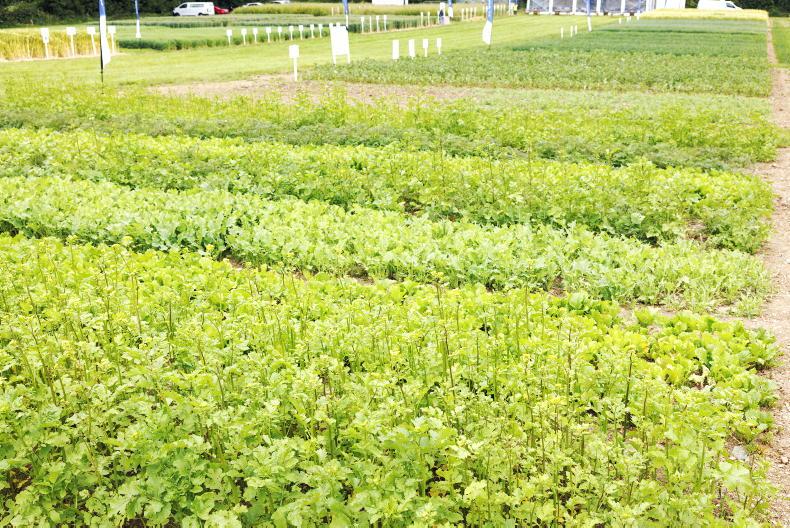




 This is a subscriber-only article
This is a subscriber-only article







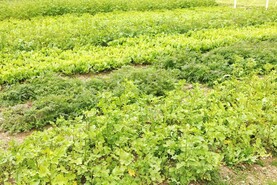


SHARING OPTIONS: